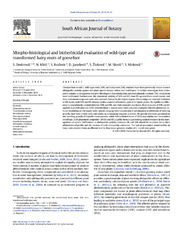Приказ основних података о документу
Morpho-histological and bioherbicidal evaluation of wild-type and transformed hairy roots of goosefoot
| dc.creator | Dmitrović, Slavica | |
| dc.creator | Banjac, Nevena | |
| dc.creator | Budimir, Snežana | |
| dc.creator | Janošević, D. | |
| dc.creator | Živković, Suzana | |
| dc.creator | Skorić, Marijana | |
| dc.creator | Ninković, Slavica | |
| dc.date.accessioned | 2016-05-23T11:00:11Z | |
| dc.date.issued | 2015 | |
| dc.identifier.issn | 1727-9321 | |
| dc.identifier.uri | https://radar.ibiss.bg.ac.rs/handle/123456789/2095 | |
| dc.identifier.uri | https://s100.copyright.com/AppDispatchServlet?publisherName=ELS&contentID=S0254629914001938&orderBeanReset=true | |
| dc.description.abstract | Chenopodium murals L. wild-type roots (WR) and hairy roots (HR) exudates have been previously shown to exert allelopathic activity against test plant species lettuce, wheat and Arabidopsis. To further investigate their allelopathic nature, a comparative morpho-histological characterization and total phenolic content (TPC) evaluation were performed. Furthermore, the phytotoxic activity of WR and HR clone R5 against three weed species and their antioxidant responses were also assessed. Except for the higher degree of branching and root hair incidence in HR clones, both WR and HR showed similar anatomical features, typical for higher plants. No significant difference in total phenolic content between WR and HRs, nor their exudates was found. Root exudates of WR and R5, applied as growth medium (GM) wherein these C. murale roots were cultured, displayed selective phytotoxic activity depending on the target weed species, ranging from suppression of germination to inhibition of seedling growth, that were linked with alterations in antioxidant enzyme activities. R5 greatly inhibited germination and seedling growth of Capsella bursa-pastoris, while WR inhibited those of Vicia angustifolia and Amaranthus retroflexus. Such phytotoxic properties (of WR and R5) qualify them as a promising natural resource in the management of weeds. Differences in allelopathic activity between HR and WR should be searched for in their allelochemical profile and the content of each allelopathic substance. The lack of anatomical abnormalities in hairy roots renders them an efficient tool for functional-genomic studies of C. murale root genes. (C) 2014 SAAB. Published by Elsevier B.V. All rights reserved. | en |
| dc.description.sponsorship | Ministry of Education, Science and Technological Development of the Republic of Serbia {[}ON173024, ON173015] | |
| dc.language | English | |
| dc.relation | info:eu-repo/grantAgreement/MESTD/Basic Research (BR or ON)/173024/RS// | |
| dc.relation | info:eu-repo/grantAgreement/MESTD/Basic Research (BR or ON)/173015/RS// | |
| dc.rights | openAccess | |
| dc.rights.uri | https://creativecommons.org/licenses/by/4.0/ | |
| dc.source | South African Journal of Botany | |
| dc.subject | Chenopodium murals | |
| dc.subject | Total phenolic content | |
| dc.subject | Bioherbicidal activity | |
| dc.subject | Histological analysis | |
| dc.subject | Vicia angustifolia | |
| dc.subject | Capsella bursa-pastoris | |
| dc.subject | Amaranthus retroflexus | |
| dc.subject | Growth medium | |
| dc.subject | Allelopathy | |
| dc.subject | Antioxidative enzymes | |
| dc.subject | Hairy roots | |
| dc.title | Morpho-histological and bioherbicidal evaluation of wild-type and transformed hairy roots of goosefoot | en |
| dc.type | article | |
| dc.rights.license | BY | |
| dcterms.abstract | Јаносевиц, Д.; Митиц, Н.; Дмитровић, Славица С.; Зивковиц, С.; Скориц, М.; Нинковић, Славица Б.; Будимир, Снежана М.; | |
| dc.rights.holder | © 2015, Elsevier | |
| dc.citation.volume | 96 | |
| dc.identifier.doi | 10.1016/j.sajb.2014.11.002 | |
| dc.identifier.scopus | 2-s2.0-84913529422 | |
| dc.identifier.wos | 000348959800008 | |
| dc.citation.spage | 53 | |
| dc.citation.epage | 61 | |
| dc.type.version | publishedVersion | en |
| dc.identifier.fulltext | https://radar.ibiss.bg.ac.rs/bitstream/id/5607/1-s2.0-S0254629914001938-main.pdf |

